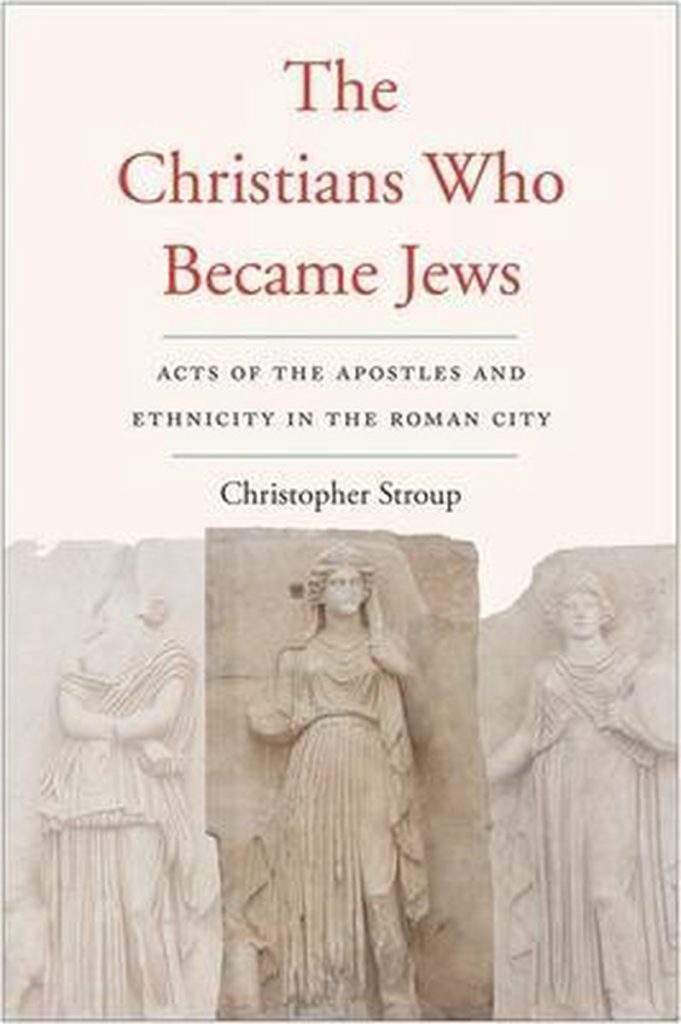
Building on research by Paula Fredriksen (e.g., From Jesus to Christ (2000), When Christians were Jews (2018 – not (yet?) included in the bibliography)) and Denise Kimber Buell (Why this Race? Ethnic Reasoning in Early Chrsitianity (2005)), this book focusses on the literary construction of Jewish and Christian identity in Acts of the Apostles. It appears in the Synkrisis-series: “Comparative Approaches to Early-Christianity in Greco-Roman Culture”. The author is a New Testament Scholar, the book is a revised edition of his Doctoral Thesis at Boston Universtiy. In it, he sketches how Luke (the supposed author of Acts of the Apostles) tries to inform his readers (non-Jews, ca. 100 CE) that the religious new-comers in the Roman world (Christians) are not members of a foreign exotic sect, but are Jews (an ethnic category the Romans were familiar with), even when they are not circumcised, or obey kashrut. To illustrate this quite provocative thesis, the author compares the way ethnicity (including the Greek term ‘proselyte’) is used in Acts with epigraphic material from the Roman Empire (from the cities of Aphrodisia and Ephesus). All these texts are written by new-comers trying to become part of the autochtone culture of the Greco-Roman cities they are living in, all using a similar literary device: In it the foundational myths of the city/people (ethnè) in question is rewritten, inserting their own ancestors (people ànd gods) into it. In so doing they claim that they – allochthones – are in reality also autochthones.
This approach turns the traditional view on Jewish identity (and the link with the Christian identity) in Acts upside-down. In the past scholars emphasized that Luke suggests that Jews and Christians are indeed related but that ethnicity is exactly where they part ways: Whereas Jewishness is an ethnic faith, Christianity is not: it is spiritual and global. That’s what scholars generally agree on, differing only in the evaluation of it. This dichotomy, however, is based on a modern outlook on ethnicity masking the intersections of civic, ethnic, and religious identifications so typical in Antiquity. The author claims that the depiction of Jewish and Christian identity should be based on an analysis of ethnicity within the context of urban life in pluralist cities in Asia-minor. Examining Acts through this lens, the scope of Luke is not so much distinguishing between Jews and Christians but legitimating the Christians by showing that they are in fact really Jewish. The statement of the question is elaborate and quite convincing (Introduction and ch. 1). The original research (the Aphrodisias inscription and the Salutaris Foundation) is interesting and instructive. The comparison of these texts with sections from Acts of the Apostles is cleverly done and challenging (ch. 2 and 3), which can not be said of the the comparison of the Ephesus procession based on the Salutaris Foundation with Paul’s second Misionary Journey through Asia Minor (ch. 4). The book showes how much biblical exegesis still has to gain from reading Bible-texts together with reading ancient culture (as represented in epigraphical and material artefacts). If one reads about Paul acting in Greco-Roman cities (= text of Acts), one should also ‘read the City’ with which he interacts (=context of Acts).
[descriptive] The book begins with an overview of the importance of ethnicity in the Roman Empire. Is appears that that in those days ethnic rhetoric serves as the overarching identity-marker, including, even absorbing civic and religious aspects. Ethnicity thus also plays a role in the formation of the new Christian identity. It’s part of a fluid and hybrid Jewish identity. If one realises this, the lists of Jews from several ‘people’ (Gr. ethnè) present at Pentecost (Acts 2:5–13) becomes revelatory with respect to the self-identification of early Christians. After situating Acts of the Apostles historically, and having examined previous scholarship on Jewish identity and Acts, the author rereads the list of ethnè present at Pentecost in Jerusalem, as the construction of a hybrid Jewish identity, in which the Christian identity can be incorporated. He does so by comparing this list to the way different ethnè are represented in an inscription in ancient Aphrodisias. (ch. 2) The book then proceeds in assessing how Acts of the Apostles uses the image of Jewishness constructed in Acts 2:5–13 to depict the Jewishness of Christian non-Jews in the Jerusalem council (15:1–21) – where kashrut and circumcision become optional within the Jewish identity. He further explores how Acts of the Apostles and the Salutaris Foundation (Ephesus) both use ethnic reasoning to expand an existing (closed) ethnic identity creating civic space for new-comers in the Roman empire. A normal procedure in Roman-era cities, in which ethnic, civic, and religious identities were so intertwined that they had become inseparable. Placing Acts within this broader ethnic discourse emphasizes the Jewishness of Christians.
The 133 pages of research are a bit encumbered by repetitive summaries and lengthy announcements. But he who perseveres will be rewarded. For the body of the book is followed by 41 pages of very interesting footnotes and 20 pages of bibliography (together sketching the field on which this research is based, offering an outlook ‘for further reading’). It concludes with three indexes : Subjects, Modern Authors and Ancient Sources. The latter rubric contains the Hebrew Bible, Deuterocanonical Books, New Testament, Rabbinic Sources, Early Jewish Writers, Early Christian Writings, Greco-Roman Literature, and Inscriptions. All together: That’s how it should be.
Dick Wursten